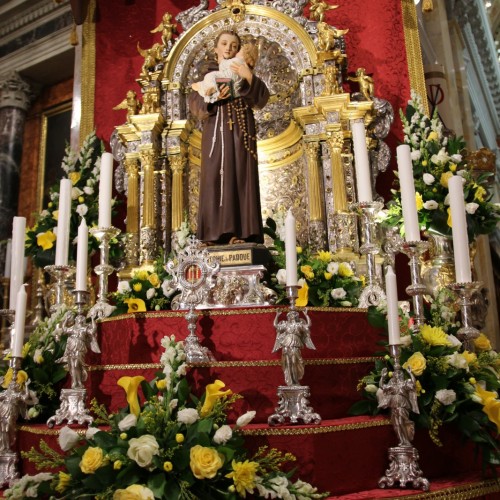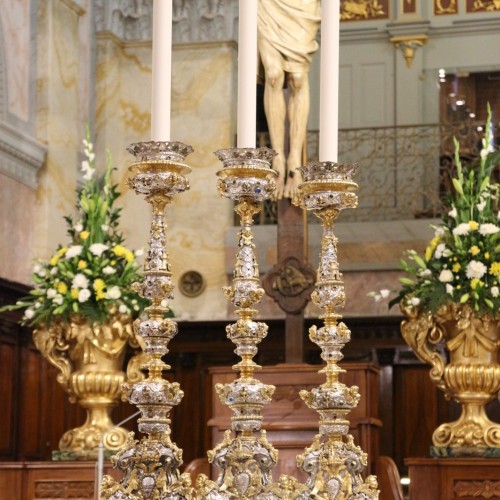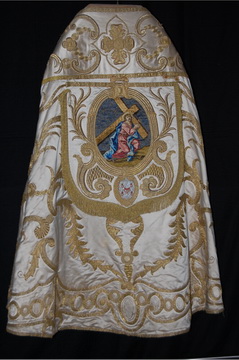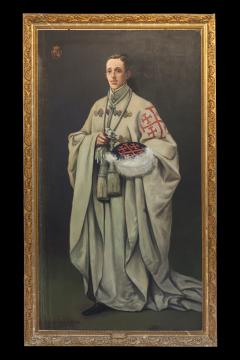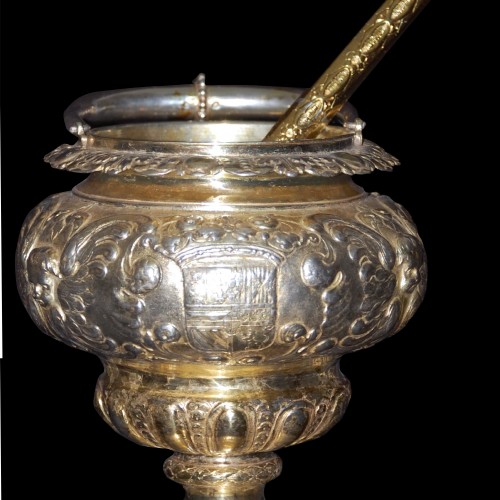Spain and the Custody of the Holy Land
The Spanish presence in the Holy Land dates back to the 13th century, when Aragonese rulers arrived in Egypt to conclude agreements with the Mamluks to protect Christian sanctuaries and their inhabitants. After the fall of the Kingdom of Jerusalem in 1291, the Franciscan Order became solely responsible for the management of the Christian sanctuaries through the Custody of the Holy Land. The Custody has relied on the internationality of its friars and the support it receives from abroad. It is a peculiarity, even today, resulting from the Franciscan presence in the Middle East.
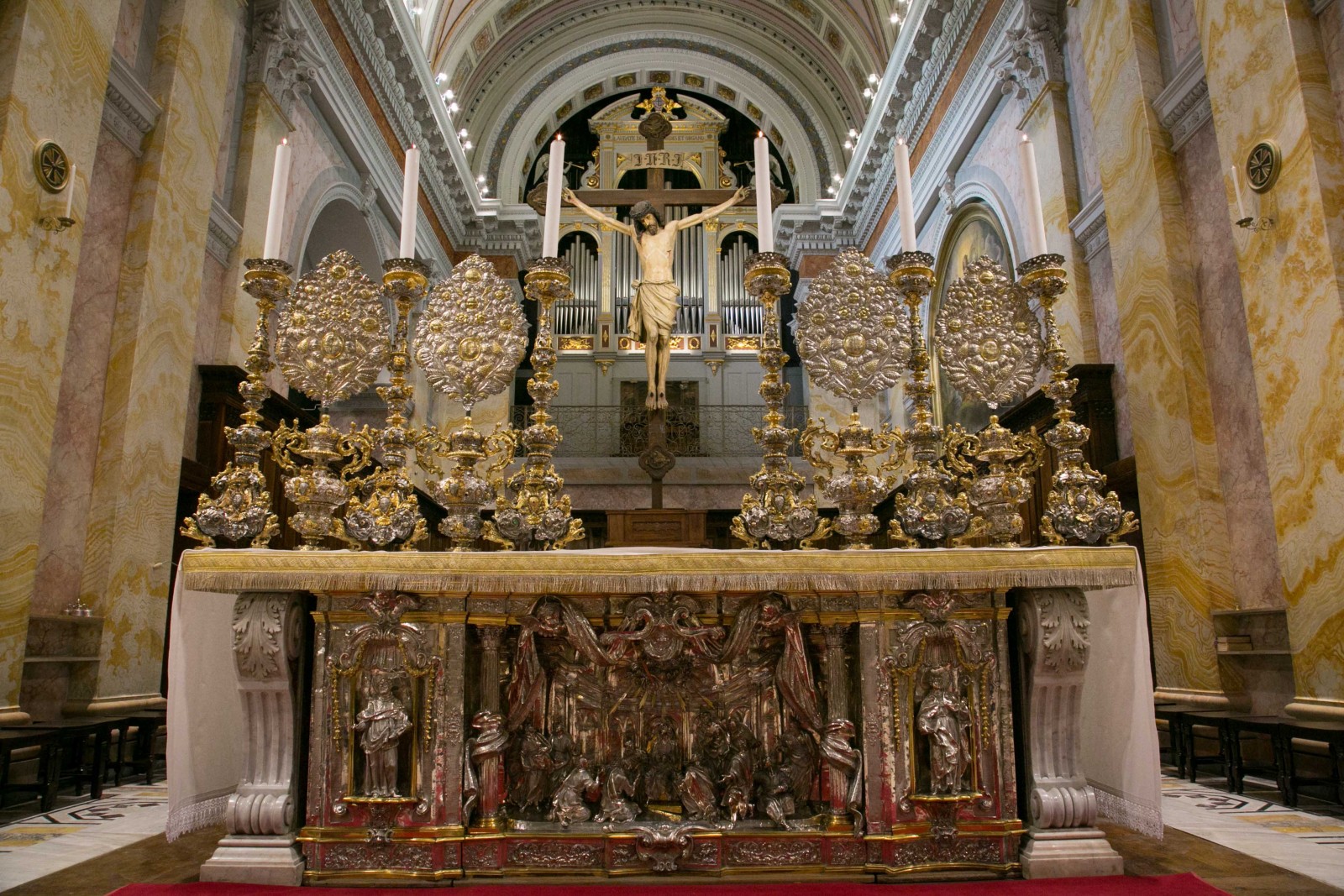
[FR]Ensemble de flambeaux et vases avec bouquets, en argent tourné, fondu, repoussé et ajouré ajouré de pierres semi-précieuses, aux armes de Philippe V (©N.Asfour/CTS)[/FR] [EN]Set of candlesticks and vases with bouquets in molten silver, hand-embossed, with openwork semi-precious stones and the arms of Philip V (©N.Asfour/CTS)[/EN]
The primary benefactors
In 1342, Robert of Anjou and Sancho of Majorca, the Kings of Naples, obtained permission from the Sultan of Egypt, through the Franciscan intermediary Rogelio Garini, the possibility to officially return to the Holy Land, ownership of the Cenacle, and the right to celebrate mass at the Holy Sepulchre.
On November 21 of the same year, Pope Clement VI released the papal bulls “Gratias Agimus” and “Nuper carissimae” establishing the Franciscans as Guardians of the Holy Places in the name of the Roman Catholic Church. This was possible thanks to the action of the Aragonese ruler who pledged to help the Franciscans in their mission to protect and keep alive the Holy Places. Later, Peter IV, the nephew of Sancho of Majorca known as “the Ceremonious,” obtained for the Franciscans and thus for the Catholic church the right to own the Holy Places; without his intervention in 1345, the Custody and the Latin Catholic presence would probably not have survived.
Loyalty of the royal houses of Spain
The marriage between Ferdinand the Catholic and Isabella, heiress of Castile placed the situation in the Holy Land at the heart of the concerns of Spanish rulers. In fact, from 1477 onward, the Franciscans experienced the generosity of Isabella the Catholic who for her entire life made donations “for her only devotion.” Sources tell us of 300 gold florins followed by the famous donation in 1489 of a thousand gold ducats. The queen, a Franciscan tertiary, constantly expressed her desire for “alms and mercy.” These donations continued until 1684, as evidenced by a certificate of Philip IV confirming the “payment of a thousand gold crowns per year.”
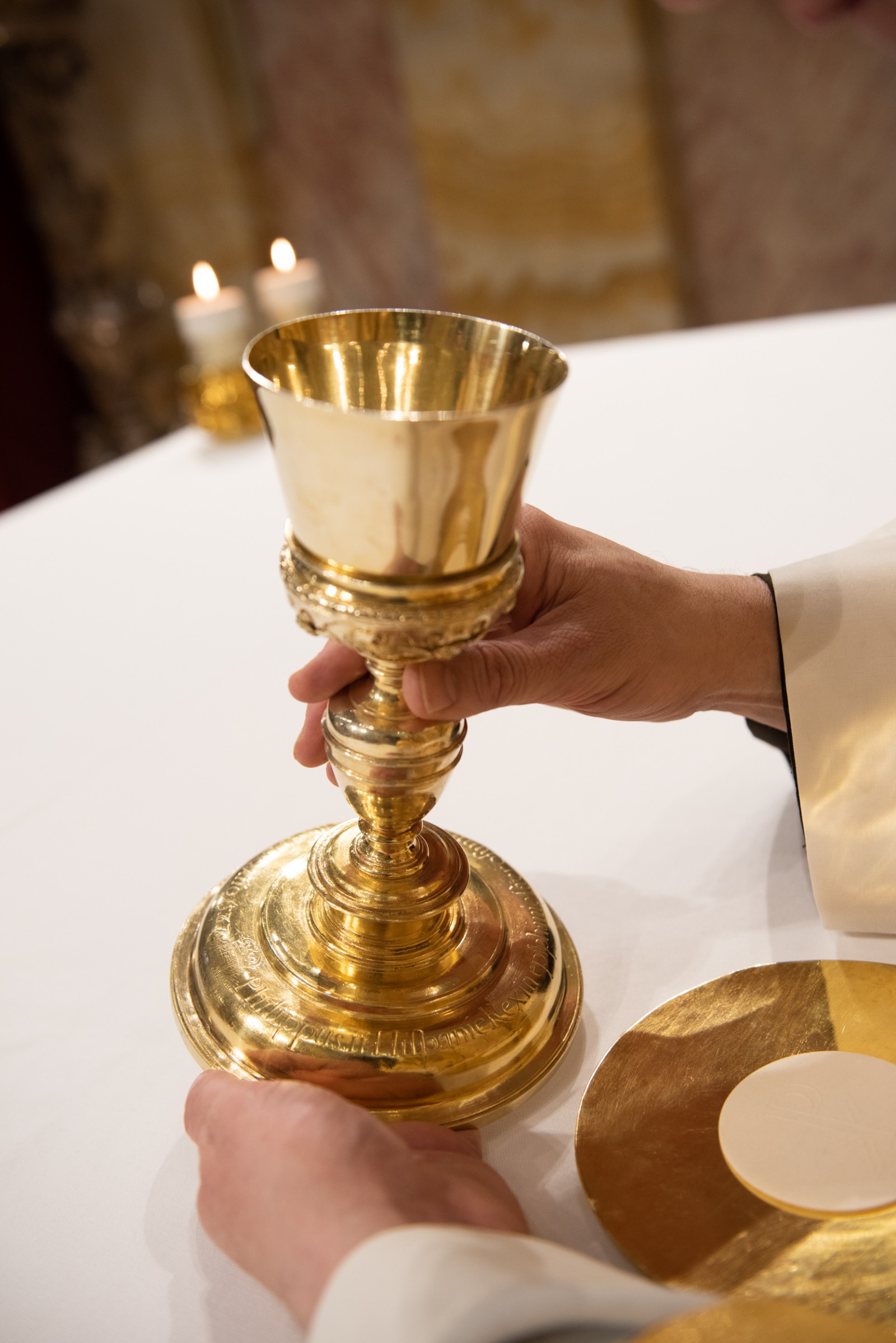
[FR]Grand calice en argent fondu, ciselé et doré, offert par Philippe II d’Espagne en 1587 (©N.Asfour/CTS)[/FR] [EN]Large chalice in molten silver, engraved and gilded, offered by Philip II of Spain in 1587 (©N.Asfour/CTS)[/EN]
At the end of the 18th century, Charles III, then King of Spain, enacted the Royal Decree of December 17, 1772 in which he reaffirmed the royal patronage of his predecessors and took charge of the ecclesiastical institution the Commissariat of the Holy Land which was up to then responsible for the collection and distribution of public funds as well as the alms of the faithful supporting the Holy Land. From then on, the king presided over the nomination of the Franciscan Commissioner of the Holy Land, and all the funds destined for the Holy Land were administered under the supervision of Spanish monarchs.
The pious works supporting the Holy Places in Jerusalem
Over the course of the 19th century, this impetus continued until the Commissariat of the Holy Land was transformed into a public body called “Obra Pía de los Santos Lugares,” or “Pious Work for the Holy Places.” It became an autonomous state institution on June 3, 1940, with legal status and its own patrimony, governed by a board of directors chaired by the Minister of Foreign Affairs.
In the mid-19th century, major changes took place in the Middle East as a result of the weakening of the Turkish Empire and the growing influence of Europe. These rivalries between powers undermined the historical role of Spain as protector of the Holy Places. On the other hand, at the end of the 19th century, the Holy See reinstated the Latin Patriarchate of Jerusalem, modifying the role allotted up until then to the Custody of the Holy Land.
It is in recognition and homage to this shared history of more than four centuries that the Terra Sancta Museum will dedicate a room to the gifts of Spanish rulers. In this way, visitors from all nations will be able to admire the splendor of Spanish sacred art, the fruit of great devotion and unique artistic practices. Each year, on the occasion of the Spanish national holiday, the Custody of the Holy Land celebrates a mass for Spain and its rulers at the Saint Savior church in Jerusalem and at the Church of the Holy Sepulchre.
————
Thank you to Brother Eduardo Masseo Gutierrez Jimenez OFM for his valuable assistance and to the website of the Spanish Ministry of Foreign affairs.

